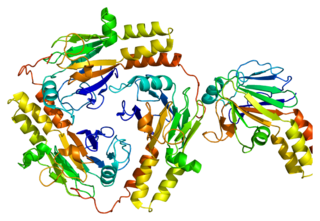
Tumor protein P53, also known as p53, cellular tumor antigen p53, the Guardian of the Genome, phosphoprotein p53, tumor suppressor p53, antigen NY-CO-13, or transformation-related protein 53 (TRP53), is any isoform of a protein encoded by homologous genes in various organisms, such as TP53 (humans) and Trp53 (mice). This homolog is crucial in multicellular vertebrates, where it prevents cancer formation, and thus functions as a tumor suppressor. As such, p53 has been described as "the guardian of the genome" because of its role in conserving stability by preventing genome mutation. Hence TP53 is classified as a tumor suppressor gene.

Mouse double minute 2 homolog (MDM2) also known as E3 ubiquitin-protein ligase Mdm2 is a protein that in humans is encoded by the MDM2 gene. Mdm2 is an important negative regulator of the p53 tumor suppressor. Mdm2 protein functions both as an E3 ubiquitin ligase that recognizes the N-terminal trans-activation domain (TAD) of the p53 tumor suppressor and as an inhibitor of p53 transcriptional activation.

Mothers against decapentaplegic homolog 1 also known as SMAD family member 1 or SMAD1 is a protein that in humans is encoded by the SMAD1 gene.

TRAF6 is a TRAF human protein.

Tuberous Sclerosis Complex 2 (TSC2), also known as Tuberin, is a protein that in humans is encoded by the TSC2 gene.

Homeodomain-interacting protein kinase 2 is an enzyme that in humans is encoded by the HIPK2 gene. HIPK2 can be categorized as a Serine/Threonine Protein kinase, specifically one that interacts with homeodomain transcription factors. It belongs to a family of protein kinases known as the DYRK kinases. Within this family HIPK2 belongs to a group of homeodomain-interacting protein kinases (HIPKs), including HIPK1 and HIPK3. HIPK2 can be found in a wide variety of species and its functions in gene expression and apoptosis are regulated by several different mechanisms.

60S ribosomal protein L5 is a protein that in humans is encoded by the RPL5 gene.

Ras-related protein Rab-1A is a protein that in humans is encoded by the RAB1A gene.

AP-3 complex subunit beta-1 is a protein that in humans is encoded by the AP3B1 gene.

60S ribosomal protein L11 is a protein that in humans is encoded by the RPL11 gene.

PNKD is the abbreviation for a human neurological movement disorder paroxysmal nonkinesiogenic dyskinesia. Like many other human genetics disorders, PNKD also refers to the disease, the disease gene and the encoded protein. (PNKD) is a protein that in humans is encoded by the PNKD gene. Alternative splicing results in the transcription of three isoforms. The mouse ortholog is called brain protein 17 (Brp17).

RING finger and CHY zinc finger domain-containing protein 1 is a protein that in humans is encoded by the RCHY1 gene.

SCY1-like 1 , also known as SCYL1, is a human gene which is highly conserved throughout evolution.

Polyhomeotic-like protein 2 is a protein that in humans is encoded by the PHC2 gene.

RING finger protein 11 is a protein that in humans is encoded by the RNF11 gene.

Golgin subfamily A member 5 is a protein that in humans is encoded by the GOLGA5 gene.

GTP-binding protein Rit1 is a protein that in humans is encoded by the RIT1 gene.

Interleukin 22 receptor, alpha 1 is a protein that in humans is encoded by the IL22RA1 gene.

TNNI3 interacting kinase is a protein that in humans is encoded by the TNNI3K gene.

Janus kinase and microtubule interacting protein 2 is a protein that in humans is encoded by the JAKMIP2 gene.
















